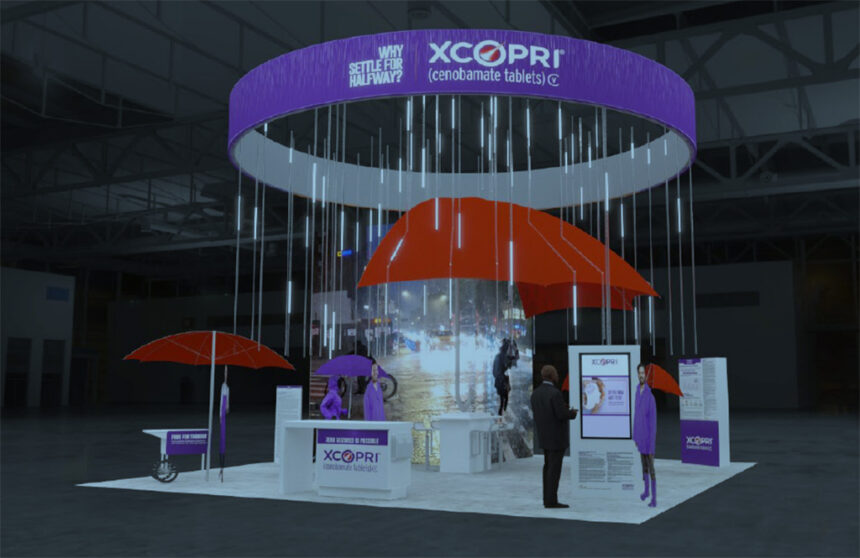The spring sun may or may not break through the Boston clouds during this weekend’s annual meeting of the American Academy of Neurology (AAN).
Regardless, it will be raining inside the exhibit hall.
At least that’s the case in one product booth, the one for anti-seizure drug Xcopri, a drug marketed by SK Life Science. Its booth for the brand will feature an immersive rainstorm experience for all to experience.
“We’re making a splash — literally,” explained Stephanie Loiseau, SK’s head of marketing. “We wanted to show an immersive experience that would be thought-provoking to physicians.”
The on-site brand team will don rain gear in purple (the brand’s color), and an umbrella looming over the booth will only cover half the area. This is meant to illustrate, in a literal way, the importance of treating the “other half.”
It’s part of a campaign, dubbed Half Way, that kicked off earlier this year referencing the industry status quo of 50% seizure reduction. Xcopri, by contrast, offers the potential of full seizure control. Data from the maintenance phase of an Xcopri clinical trial showed that as many as one-in-five patients experienced zero seizures.
It’s just the latest iteration of SK’s efforts to raise awareness of Xcopri’s efficacy since the three-year-old brand launched during the COVID-19 pandemic. Past efforts have included the Zero Seizures branded consumer website and a YouTube channel featuring a series of authentic patient stories.
With more than 30 anti-seizure medications (ASMs) on the market, “It will take time to differentiate,” said Matthew Linkewich, SK’s chief commercial officer. Epileptologists and neurologists, he noted, have ingrained prescribing habits.
While there have been no head-to-head trials, other ASMs offer closer to a one in 20 chance of seizure freedom, said Loiseau, adding that real-world Xcopri data have suggested even better results than the trial.
As to the rationale for striving for 100% seizure freedom, “Epilepsy is a debilitating condition,” she pointed out. “The depression and employment numbers are staggering. If you only go to 50%, it doesn’t enable you to drive or get a job. That’s the idea: to push the physician to go all the way. We tested this in market research and physicians were drawn to this idea because it showed them there are other options. It made them rethink their approach to epilepsy.”
AAN, which runs from April 22 to 27, is an important venue to get that point across.
“We’re the No. 1 branded anti-seizure medication with epileptologists,” Loiseau noted. “Where there’s a big opportunity is with neurologists, who make up a large majority of the HCP market.”
With so many other neurological diseases top of mind, from migraine to movement disorders and pain, epilepsy represents just 15% of their patients. The effort is meant to raise awareness among this particular group of specialists.
However, AAN is just one piece of the puzzle. Since Half Way was launched at SK’s national sales meeting in February, the field force has been using the newer visual aids to support conversations with doctors. The company has also seen an increase in NRx.
“We’ve seen over 40% growth versus the same time last year in the number of new patients getting put on Xcopri,” reported Linkewich “It’s been a nice growth trend and we look forward to seeing this accelerate.”
SK is following an omnichannel approach, with print ads, banners, emails, display and social media, which has become the second-leading driver to site after paid search. CDM Princeton designed the AAN display, based on the initial concept by Creative Artists Agency (CAA). It’s a concept which seems eminently campaignable.
“The thing we love about this campaign is it has a lot of legs,” said Loiseau. “We see this evolving outside the half umbrella: half a book tells half a story, a glass being half full, or going down to the 50-yard line. There are so many creative variations, and we won’t stop until we’re not just number one with epileptologists but with neurologists, too.”
Meanwhile at the AAN booth, plans call for the simulated squall to be displayed on a giant LED screen. However, it wasn’t the team’s first choice. Loiseau said the company initially wanted to pipe in real water.
“Unfortunately, the building wouldn’t allow that,” she said.








